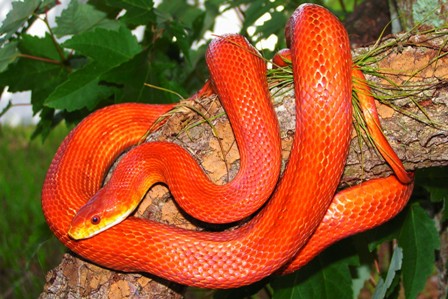Type the name of the breed you're looking for below
[wpdreams_ajaxsearchlite] Don't see the breed your're looking for? Click here and let us know!
Everglades Rat Snake
| Place of Origin and Range | Once found from Florida's Kissimmee prairie south to the saw grass covered Everglades, habitat destruction has made this species rare in the wild. |
| Description | Newborns have a dull pattern of grey blotches on a grey background; the overall colouration often has an orange, or pinkish wash. Adults have four indistinct dorsal and lateral stripes on a warm orange to rust-coloured background. The eyes and tongue are red. |
| Morph Patterns Available | Yes |
| Adult Size | Can grow 5-7 feet(1.5 - 2.1m) |
| Accommodation | These snakes like plains and grassland. Mild humidity with loose earth for burrowing. Large branches for simulated trees. You will always want to include a large dish for bathing and soaking in to improve shedding. Always include a day basking spot at 80'F(27'C). Along with multiple hides. Minimum 2 x 2 x 4 feet for an adult. |
| Lifespan | Can live 15- 20 years |
| Feeding / Diet | Like most rat snakes they can eat mice, and rats depending on the size of your snake and the availability of feed. |
| Breeding | These snakes generally start to mate in late April, May and early June after the winter hibernation. Males tend to attract females with pheromones as the females pass through their territories. Interestingly, male snakes, tend to pursue female snakes until they can coil around them. They continue in such position, which is then followed by dancing for up to an hour before mating. During the mating, the male snake will line up with the female and hold her in place by wrapping his tail around hers and grasping her with his mouth. Then, the male will insert one of his hemipenes into the female’s cloaca. The mating process lasts from a few minutes to a few hours. After mating the female will seek an appropriate place to lay the developing eggs. They usually lay eggs in the soft heart of a rotten log or in sandy soil under a rock. A good place for laying eggs is one that is damp but not wet, and warm but not hot. After laying eggs, the female snake will cover them up with sand or dirt and leave. A few species will stay with the eggs until they hatch about 9 weeks later. |
| Other Considerations | Snakes are relatively hardy low maintenance animals when kept in the correct environment, and require little day to day care other than feeding and cleaning out the tank as required. However, like all animals, they can still become sick or injured despite our best intentions to prevent this. |



